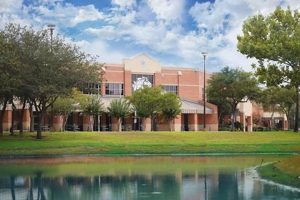Highly selective institutions emphasizing undergraduate education while offering competitive athletic opportunities characterize the top liberal arts colleges and universities competing at the NCAA Division III level. These schools typically feature small class sizes, close faculty-student interaction, and a focus on a well-rounded education encompassing the humanities, sciences, and arts. For example, a student-athlete might major in biology while playing basketball, receiving personalized instruction in both areas.
Combining rigorous academics with competitive athletics offers significant advantages. Students develop time management skills, leadership qualities, and a strong sense of community. Historically, the emphasis on the student aspect of student-athlete emerged as a way to maintain the amateur spirit of college sports while still allowing for high levels of competition. This dedication to balanced development prepares graduates for success in diverse professional fields and graduate studies.
Understanding the unique characteristics of these institutions is essential when considering college options. The following sections will explore specific factors that define academic excellence in Division III athletics, including faculty resources, curriculum rigor, and post-graduate outcomes.
Applying to institutions recognized for both academic rigor and competitive Division III athletics requires careful planning and a thorough understanding of the process. These tips offer guidance for prospective student-athletes.
Tip 1: Research Early and Thoroughly: Investigate institutions beyond athletic rankings. Explore academic departments, research opportunities, and faculty expertise to identify programs aligned with individual interests.
Tip 2: Demonstrate Genuine Academic Interest: Strong academic credentials are paramount. A rigorous high school curriculum and excellent grades demonstrate preparedness for a challenging academic environment.
Tip 3: Connect with Coaches Proactively: Reach out to coaching staff early and maintain regular communication. Express genuine interest in the program and highlight relevant athletic achievements.
Tip 4: Craft Compelling Essays: Application essays provide opportunities to showcase personality, values, and experiences. Articulate how academic and athletic pursuits complement each other.
Tip 5: Secure Strong Letters of Recommendation: Request recommendations from teachers, counselors, and coaches who can speak to academic abilities, character, and athletic potential. Provide them with ample time and information.
Tip 6: Prepare for Standardized Testing: While some institutions are test-optional, strong standardized test scores can enhance an application. Plan and prepare accordingly.
Tip 7: Visit Campuses and Attend Events: Whenever possible, visit campuses to experience the environment firsthand. Attending athletic events provides insight into team dynamics and coaching styles.
By following these guidelines, prospective students can effectively navigate the application process, increasing their chances of acceptance into institutions offering both challenging academics and competitive Division III athletics. This preparation can significantly impact future academic and athletic success.
The intersection of academic excellence and athletic pursuits in Division III institutions offers a unique environment for student growth and development. The concluding section will summarize key takeaways and offer final considerations for prospective applicants.
1. Rigorous Academics
Rigorous academics form a cornerstone of institutions considered among the best academic Division III schools. A demanding curriculum, high faculty expectations, and an emphasis on critical thinking contribute to a challenging yet rewarding learning environment. This academic rigor prepares students not only for successful graduate studies but also for diverse career paths requiring analytical skills and adaptability. The commitment to academic excellence attracts highly motivated students, creating a stimulating intellectual community. Institutions like Swarthmore College and Pomona College, known for their demanding academics, consistently produce graduates who excel in various fields.
The emphasis on rigorous academics in these environments fosters intellectual curiosity and a deep understanding of chosen disciplines. Students are challenged to engage with complex material, conduct independent research, and develop sophisticated analytical skills. This focus on depth over breadth allows for a more immersive and transformative educational experience. For example, a student majoring in physics at a highly selective Division III college might conduct publishable research alongside a faculty mentor, gaining experience comparable to students at larger research universities.
Recognizing the significance of rigorous academics within the context of Division III athletics provides valuable insight for prospective students. Understanding the commitment required to succeed in these demanding academic environments allows individuals to make informed decisions about their college choices. Institutions prioritizing both academic excellence and competitive athletics offer a unique opportunity for students to develop a broad range of skills and prepare for fulfilling personal and professional lives. This combination distinguishes the best academic Division III schools, attracting students seeking a comprehensive and enriching undergraduate experience.
2. Competitive Athletics
Competitive athletics plays a significant role in the overall educational experience offered by top academic Division III schools. While academics remain a primary focus, the commitment to competitive athletics offers distinct advantages, contributing to well-rounded student development. The demanding training schedules and the drive for excellence required in competitive sports cultivate discipline, time management skills, and resiliencequalities highly valued in both academic and professional pursuits. Furthermore, team dynamics foster collaboration, leadership skills, and a strong sense of community. Institutions like Middlebury College and Washington University in St. Louis demonstrate how a thriving athletic program can complement a rigorous academic environment, enhancing the overall student experience. A student-athlete juggling varsity soccer and a demanding course load in biochemistry, for instance, develops valuable time management and prioritization skills applicable to future career challenges.
The integration of competitive athletics within a demanding academic setting can lead to significant positive outcomes. Student-athletes often develop a strong work ethic and learn to balance multiple commitments effectively. This ability to manage time and prioritize tasks efficiently translates to success in academic pursuits, extracurricular activities, and future professional endeavors. Moreover, the collaborative nature of team sports promotes teamwork and communication skills, essential for navigating complex projects and working effectively in collaborative environments. For instance, a student participating in debate and also competing on the track team develops critical thinking skills in both arenas and learns to thrive under pressure. These experiences collectively prepare students for the demands of postgraduate education and professional careers.
Understanding the integral role of competitive athletics in the educational framework of leading Division III institutions offers valuable insights. These programs provide an environment where students can develop valuable life skills alongside academic expertise. While the pursuit of athletic excellence requires dedication and commitment, the benefits extend beyond the playing field, contributing to well-rounded individuals prepared to excel in various aspects of life. This dedication to both academics and athletics contributes significantly to the overall educational value proposition of these highly selective institutions. The rigorous demands of both pursuits cultivate characteristics essential for success in a complex and competitive world.
3. Faculty Engagement
Faculty engagement represents a crucial element distinguishing top-tier academic Division III institutions. Close interaction with faculty fosters a personalized learning experience, significantly impacting student development and academic success. This level of engagement goes beyond traditional classroom instruction, encompassing mentorship, research collaboration, and intellectual exchange outside of formal coursework.
- Mentorship and Advising
Faculty members in highly regarded Division III schools often serve as mentors, providing guidance on academic and career paths. This personalized attention allows students to explore their interests deeply and develop individualized learning plans. For example, a professor might guide a student interested in environmental science toward relevant research opportunities or connect them with professionals in the field. This individualized support fosters intellectual growth and enhances career preparation.
- Research Collaboration
Opportunities for undergraduate research represent a hallmark of strong Division III institutions. Students frequently collaborate with faculty on research projects, gaining valuable hands-on experience and contributing to original scholarship. This direct involvement in the research process fosters critical thinking skills, cultivates a deeper understanding of the subject matter, and strengthens students’ resumes for graduate school or professional careers. A student working alongside a history professor on archival research, for instance, gains insights into historical methodology while contributing to the field’s existing knowledge base.
- Accessibility and Open Dialogue
Small class sizes and a student-centered environment contribute to increased faculty accessibility. Students benefit from informal interactions with professors outside of the classroom, fostering deeper intellectual exchange. This open dialogue promotes critical thinking, encourages active learning, and creates a vibrant intellectual community. A student might discuss a challenging philosophical concept with a professor during office hours, benefiting from personalized insights and clarification.
- Networking and Professional Development
Faculty connections often extend beyond the academic realm, providing students with valuable networking opportunities. Professors can connect students with alumni working in their fields of interest, opening doors for internships, research positions, or mentorship opportunities. This networking can be instrumental in launching successful careers after graduation. A student pursuing a career in journalism, for example, might benefit from faculty connections to established journalists, gaining valuable industry insights and potential career opportunities.
These facets of faculty engagement collectively contribute to the enriching academic experience characteristic of the best Division III schools. The close interaction between faculty and students fosters a supportive learning environment that promotes intellectual curiosity, academic excellence, and successful career preparation. This personalized approach to education differentiates these institutions, offering students a unique advantage in their academic and professional development.
4. Small Class Sizes
Small class sizes represent a defining characteristic of many institutions recognized as the best academic Division III schools. This pedagogical approach fosters a learning environment conducive to individualized attention, active participation, and close faculty-student interaction, contributing significantly to the overall educational experience. The following facets highlight the benefits of small class sizes within this context.
- Enhanced Student-Faculty Interaction
Reduced class sizes facilitate more frequent and meaningful interactions between students and faculty. This increased interaction allows for personalized feedback, tailored instruction, and greater opportunities for mentorship. For example, in a small seminar on Shakespeare, a professor can engage in in-depth discussions with each student, providing individualized guidance on their interpretations of the text. This level of interaction strengthens student understanding and fosters a deeper appreciation of the subject matter.
- Increased Student Participation
Smaller classes encourage active participation and create a more comfortable environment for students to contribute to discussions. This active engagement promotes critical thinking, enhances communication skills, and fosters a deeper understanding of the material. In a small political science class, students might engage in a lively debate about current events, developing their analytical skills and refining their ability to articulate complex ideas.
- Individualized Attention and Support
Small class sizes enable faculty to provide more individualized attention and support to each student. This personalized approach allows professors to identify individual learning styles, address specific challenges, and tailor instruction to meet diverse needs. A student struggling with a particular concept in calculus, for example, can receive individualized guidance from the professor during class or during office hours, ensuring a deeper understanding of the material.
- Stronger Sense of Community
Smaller classes often foster a stronger sense of community among students. This close-knit environment promotes collaboration, peer learning, and a supportive network of classmates. Students in a small creative writing workshop, for instance, might provide constructive feedback on each other’s work, fostering a sense of camaraderie and mutual support.
These interconnected benefits of small class sizes contribute significantly to the high-quality education provided by the best academic Division III schools. The personalized learning environment, increased student engagement, and close faculty interaction foster intellectual growth, enhance critical thinking skills, and prepare students for success in graduate programs and diverse career paths. This focus on individualized learning distinguishes these institutions, providing students with a distinct advantage in their academic and professional pursuits. This emphasis on small class sizes underscores the commitment of these institutions to providing a high-quality, student-centered learning experience.
5. Undergraduate Focus
A hallmark of Division III institutions, particularly those recognized for academic excellence, is their prioritization of undergraduate education. This dedicated focus shapes the academic environment, influencing faculty interaction, resource allocation, and overall institutional priorities. It directly contributes to the high-quality, personalized learning experience often associated with the best academic Division III schools. This emphasis distinguishes these institutions from universities with larger graduate programs, where research and graduate education may sometimes overshadow undergraduate needs.
- Dedicated Faculty
Faculty at undergraduate-focused Division III institutions dedicate their time and expertise primarily to teaching and mentoring undergraduates. This concentrated effort translates to increased accessibility, personalized instruction, and opportunities for close collaboration on research projects. For instance, professors at a small liberal arts college might teach smaller classes and advise undergraduate theses, dedicating significant time to individual student development. This contrasts with larger universities where faculty may prioritize research and graduate student mentorship.
- Resource Allocation
Institutions prioritizing undergraduate education often allocate resources strategically to enhance the undergraduate experience. This may include investments in state-of-the-art teaching facilities, undergraduate research programs, and academic support services. For example, a college might invest in a new science building equipped with advanced laboratories specifically designed for undergraduate research, demonstrating a commitment to hands-on learning. This prioritization of undergraduate resources fosters a stimulating academic environment.
- Curriculum Design
Curriculum design in undergraduate-focused institutions often emphasizes breadth and depth of knowledge within a liberal arts framework. Students are encouraged to explore diverse disciplines while also developing expertise in their chosen fields. For instance, a student might major in history while also taking courses in computer science and studio art, fostering intellectual curiosity and a well-rounded education. This approach prepares students for a wide range of career paths and postgraduate opportunities.
- Community Engagement
Undergraduate-focused environments often foster a strong sense of community, both within and beyond the classroom. Smaller student populations, dedicated faculty, and a shared focus on undergraduate learning contribute to a close-knit academic environment. This sense of community can lead to increased collaboration, peer learning, and a more supportive and engaging academic experience. For instance, students might participate in campus-wide events, engage in community service projects, or collaborate on research initiatives, fostering a sense of belonging and shared purpose.
This concerted focus on undergraduate education contributes significantly to the academic distinction of top Division III schools. The dedicated faculty, strategic resource allocation, tailored curriculum design, and strong sense of community collectively create an enriching learning environment that fosters intellectual growth, personal development, and career preparation. These factors distinguish leading undergraduate-focused institutions, offering students a unique and highly valuable educational experience.
6. Research Opportunities
Substantial research opportunities represent a key characteristic distinguishing high-ranking academic Division III institutions. These opportunities offer undergraduates experiences typically associated with larger research universities, significantly enhancing their educational journey. Engaging in research cultivates critical thinking, problem-solving skills, and in-depth knowledge within a specific field. This active learning process fosters intellectual curiosity and prepares students for the rigors of graduate studies or professional careers requiring analytical thinking and independent work. For example, a biology student at a leading liberal arts college might conduct independent research on the genetic basis of a particular disease, gaining valuable laboratory experience and contributing to scientific knowledge. This hands-on involvement not only deepens understanding but also fosters essential research skills.
The availability of research opportunities within Division III institutions demonstrates a commitment to providing a high-quality, comprehensive undergraduate education. Such opportunities frequently involve close collaboration with faculty mentors, fostering personalized learning and professional development. A student interested in astrophysics, for instance, might work alongside a professor analyzing data from a space telescope, gaining exposure to cutting-edge research methodologies and instrumentation. This mentorship not only provides valuable guidance but also establishes connections that can be instrumental for future career opportunities. The emphasis on research at the undergraduate level signifies a dedication to fostering intellectual curiosity and preparing students for future success in diverse fields.
Understanding the significance of research opportunities in the context of academically distinguished Division III colleges is essential for prospective students. These opportunities represent a valuable asset, contributing significantly to a well-rounded education. The ability to conduct meaningful research as an undergraduate provides a distinct advantage, enhancing applications for graduate programs and demonstrating a commitment to intellectual inquiry. Ultimately, access to such experiences strengthens the academic profile of these institutions and provides students with valuable skills applicable to a wide range of future endeavors. The availability and accessibility of research opportunities serve as a critical factor in determining the overall academic quality and reputation of these highly selective institutions.
7. Community Engagement
Community engagement serves as a vital component distinguishing high-ranking academic Division III institutions. This involvement extends beyond the confines of campus, fostering reciprocal relationships with surrounding communities. Such engagement benefits both students and the community, enriching the educational experience while contributing to positive social impact. Students at these institutions often participate in service-learning projects, volunteer activities, and community-based research, applying academic knowledge to real-world challenges and developing a sense of civic responsibility. For example, students in a sociology class might partner with a local non-profit organization to address food insecurity, gaining practical experience while contributing to a meaningful cause. This integration of academic learning and community engagement fosters a deeper understanding of social issues and cultivates a commitment to service.
The emphasis on community engagement within these institutions reflects a commitment to fostering well-rounded individuals prepared to contribute meaningfully to society. Experiences gained through community involvement complement academic learning, providing valuable practical skills and fostering personal growth. Students develop empathy, leadership qualities, and a deeper understanding of diverse perspectives through interactions with community members. A student volunteering at a local hospital, for instance, gains valuable experience in a healthcare setting while developing compassion and interpersonal skills. These experiences contribute to a more holistic education, preparing graduates for engaged citizenship and responsible leadership.
Integrating community engagement into the fabric of these institutions strengthens their overall educational mission. It fosters a sense of interconnectedness, promotes active citizenship, and provides students with opportunities to apply their knowledge and skills in meaningful ways. Challenges such as ensuring equitable partnerships and measuring the impact of community engagement require ongoing attention. However, the demonstrable benefits of community engagement solidify its importance as a defining characteristic of the best academic Division III schools. This commitment to community involvement underscores the value these institutions place on educating students not only for personal success but also for responsible and engaged citizenship.
Frequently Asked Questions
This section addresses common inquiries regarding institutions renowned for strong academics and Division III athletics.
Question 1: What distinguishes Division III athletics from Division I and II?
Division III prioritizes the student-athlete experience, emphasizing academic achievement and a balanced lifestyle. Athletic scholarships are not offered, allowing students to compete for the love of the sport while pursuing rigorous academic programs. Competition schedules are designed to minimize interference with academic commitments.
Question 2: How important are standardized test scores for admission to academically rigorous Division III colleges?
While standardized test scores are considered, these institutions conduct a holistic review process. Academic performance, rigor of curriculum, extracurricular activities, essays, and letters of recommendation all play significant roles in the evaluation process. Some institutions may be test-optional.
Question 3: Can student-athletes at academically challenging Division III schools also participate in other extracurricular activities?
Absolutely. A well-rounded experience is encouraged. Many student-athletes participate in clubs, organizations, research projects, and community service initiatives, demonstrating their diverse interests and commitment to a balanced lifestyle.
Question 4: What are the typical class sizes at these institutions, and how does this impact learning?
Class sizes tend to be small, facilitating close interaction with faculty, personalized instruction, and increased student participation. This environment fosters a strong sense of community and allows for more individualized attention from professors.
Question 5: What kind of career support do these institutions offer student-athletes?
Career services offices and dedicated athletic advisors provide comprehensive support, including internship placement, resume and cover letter assistance, interview preparation, and networking opportunities. These resources help student-athletes explore career options and prepare for professional success after graduation.
Question 6: What is the role of research in undergraduate programs at these institutions?
Undergraduate research is often highly valued and widely available. Students frequently have opportunities to work closely with faculty on research projects, gaining valuable hands-on experience, contributing to original scholarship, and enhancing their preparation for graduate studies or careers in research-intensive fields.
Understanding these aspects provides valuable insight for prospective students considering institutions known for both academic excellence and competitive Division III athletics. This information can assist individuals in making informed decisions about their college choices.
This concludes the frequently asked questions section. The next section will offer concluding thoughts and summarize key takeaways for prospective students.
Conclusion
Institutions offering top-tier academics coupled with Division III athletics provide a distinct educational experience. Key characteristics include rigorous academic programs, competitive athletic opportunities, engaged faculty, small class sizes, a focus on undergraduate education, access to research, and a commitment to community engagement. These factors combine to create an environment fostering intellectual growth, personal development, and preparation for diverse career paths and graduate studies. The emphasis on a balanced approach to academics and athletics cultivates time management skills, leadership qualities, and a strong sense of community, enriching the overall undergraduate experience.
Choosing a college represents a pivotal decision. Careful consideration of individual academic and athletic aspirations, alongside the unique environment offered by institutions prioritizing both, is crucial. Institutions emphasizing academic excellence within the context of Division III athletics provide a pathway for students seeking a challenging and rewarding undergraduate experience, preparing them for success in their chosen fields and beyond. The combination of academic rigor and competitive athletics cultivates well-rounded individuals equipped to navigate the complexities of a demanding world.







